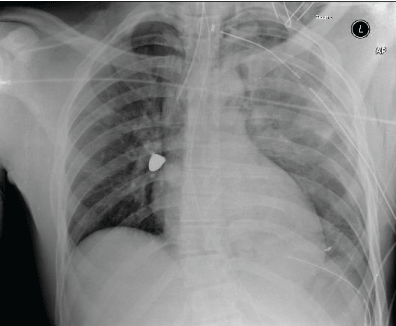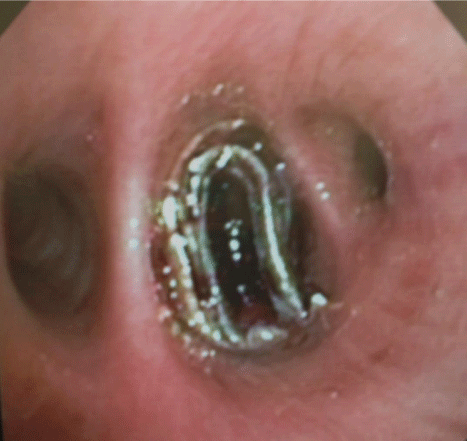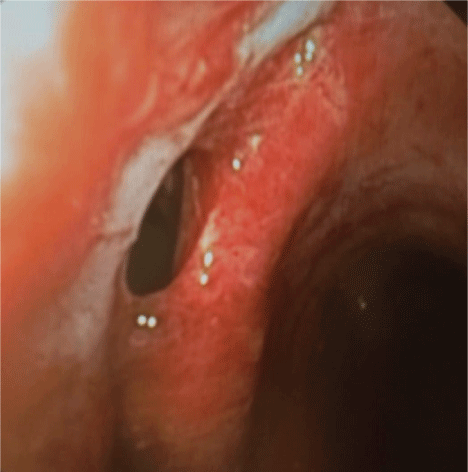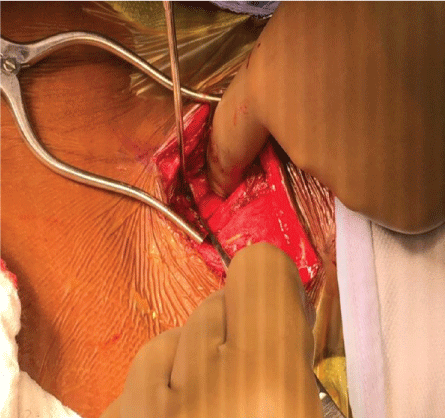Trauma Cases and Reviews
Gun Shot Wound to Left Chest with "Transmediastinal" Trajectory. A Case Report and Review
Reilly D. Hobbs1*, Joshua A. Marks2, John C. Kucharczuk3 and Patrick M. Reilly2
1Department of Surgery, University of Pennsylvania, USA
2Department of Surgery, Division of Traumatology, Surgical Critical Care, and Emergency Surgery, University of Pennsylvania, USA
3Department of Surgery, Division of Thoracic Surgery, University of Pennsylvania, USA
*Corresponding author: Reilly D. Hobbs, Surgery Resident, PGY-IV, Hospital of the University of Pennsylvania, USA, Tel: 215-519-5687, E-mail: Reilly.Hobbs@uphs.upenn.edu
Trauma Cases Rev, TCR-1-009, (Volume 1, Issue 2), Case Report; ISSN: 2469-5777
Received: August 11, 2015 | Accepted: September 16, 2015 | Published: September 18, 2015
Citation: Hobbs RD, Marks JA, Kucharczuk JC, Reilly PM (2015) Gun Shot Wound to Left Chest with "Transmediastinal" Trajectory. A Case Report and Review. Trauma Cases Rev 1:009. 10.23937/2469-5777/1510009
Copyright: © 2015 Hobbs RD, et al. This is an open-access article distributed under the terms of the Creative Commons Attribution License, which permits unrestricted use, distribution, and reproduction in any medium, provided the original author and source are credited.
Case Description
A 21-year old African American male presented with a single gunshot wound to the left posterior chest inferior and medial to the scapular spine. EMS performed a left needle thoracostomy for tension pneumothorax. In the trauma bay, the patient was hemodynamically stable with a GCS 15 and moving all extremities. A chest tube was placed with an initial output of 700 mL of blood and the patient was intubated. A portable chest radiograph demonstrated a bullet overlying the right inferior hilum (Figure 1). Secondary survey noted left chest wall and neck subcutaneous emphysema. Given the patient's stability, a computed tomography angiogram (CTA) of the neck and chest was obtained to assess vessels and trajectory. CTA showed no major vascular injury. The bullet was located in the right inferior pulmonary hilum, but there was no obvious trajectory landing the bullet in the contralateral hemithorax. A large amount of pneumomediastinum suggested a large airway injury (Figure 2).

.
Figure 1: Portable AP Chest radiograph demonstrating a metallic fragment (single arrow) in the right chest after a left sided GSW to the posterior chest that was marked with a paperclip (double arrow)
View Figure 1

.
Figure 2: Coronal section of a CTA demonstrating a large metallic fragment in the right pulmonary hilum without obvious great vessel, cardiac, tracheal, esophageal, or bronchial injuries.
View Figure 2
The patient was brought to the operating room for bronchoscopy, esophagoscopy and possible thoracic exploration. On bronchoscopy, a bullet was seen lodged in the right bronchus intermedius concerning for bullet aspiration from a left sided pulmonary wound or proximal airway injury (Figure 3). On further bronchoscopic evaluation, a hole was identified on the left anterolateral wall of the cervical trachea at the thoracic outlet (Figure 4). Esophagoscopy was unremarkable for injury.

.
Figure 3: Bronchoscopic view of a bullet fragment occluding the right bronchus intermedius. This bullet was successfully retrieved using endoscopic forceps and controlled extubation with subsequent reintubation.
View Figure 3

.
Figure 4: Bronchoscopic view of the left anterolateral bullet wound to the cervical trachea. This view was obtained after partial withdrawal of the endotracheal tube to allow proximal visualization.
View Figure 4
The bullet was retrieved with endoscopic forceps and bronchoscope withdrawal. This necessitated controlled extubation and reintubation, as the bullet diameter was larger than the endotracheal tube. The left neck was then explored via incision along the anterior border of the sternocleidomastoid (Figure 5). The tracheal injury, at the inferior aspect of the incision, was repaired primarily with interrupted absorbable suture and buttressed with a muscle flap from the SCM.

.
Figure 5: Operative view of the left neck with exposure of a tracheal bullet injury (white arrow). The bullet entered the body through the left posterior chest then entered the trachea before aspiration into the right bronchus intermedius.
View Figure 5
The patient recovered well and was discharged post-injury day five without event.
Discussion
This is a rare case of a gunshot wound to the posterior chest with concern for a transmediastinal trajectory that ricocheted into the cervical trachea resulting in bullet aspiration into the right bronchus intermedus. To our knowledge, this is the first published case of a thoracic gunshot wound resulting in an isolated cervical tracheal injury. Radiographically there was a peripheral lung injury and a large amount of pneumomediastinum. No disruptions to the tracheobronchial tree were identified. Due to bullet scatter, we were unable to decipher whether the bullet in the right inferior hilum was adjacent to, or inside the bronchus.
Tracheal injury after penetrating chest wounds is rare and usually associated with other injuries to the great vessels, lung, and heart. Transmediastinal bullet trajectory is typically fatal prior to hospital presentation. Initial imaging suggested our patient suffered a transmediastinal bullet wound with a likely aerodigestive tract injury. Identified aerodigestive injuries after mediastinal gunshot wounds occurs in less than 1% of patients, likely due to the high initial mortality rates from these injuries [1,2]. In hemodynamically stable patients, CT angiography combined with endoscopy is recommended for initial evaluation of injuries. In hemodynamically unstable patients, emergent surgery combined with endoscopy is recommended.
Bullet aspiration into the pulmonary tree is a rare occurrence with few reports in the literature [3-6]. There are no previous reports of thoracic gunshot wounds resulting in cervical tracheal injury and bullet aspiration. This case highlights the importance of endoscopy in the evaluation of penetrating mediastinal injuries with the caveat that cervical tracheal injuries should not be excluded. When bullet fragments are found in the pulmonary tree without obvious injury, it is important to evaluate the proximal trachea with partial endoscope and / or endotracheal tube withdrawal.
References
-
Okoye OT, Talving P, Teixeira PG, Chervonski M, Smith JA, et al. (2013) Transmediastinal gunshot wounds in a mature trauma centre: changing perspectives. Injury 44: 1198-1203.
-
Burack JH, Kandil E, Sawas A, O'Neill PA, Sclafani SJ, et al. (2007) Triage and outcome of patients with mediastinal penetrating trauma. Ann Thorac Surg 83: 377-382.
-
Choh JH, Adler RH (1981) Penetrating bullet wound of chest with bronchoscopic removal of bullet. J Thorac Cardiovasc Surg 82: 150-153.
-
Madureira AJ, Vieira AM, Magalhaes A, Ramos IM (2001) Gunshot wound and bullet 'aspiration'. Pediatr Radiol 31: 758.
-
O'Connor JV, Haan JM, Wright JL (2006) Spent bullet in the bronchus. Am Surg 72: 345-346.
-
Lax EA, Kiran SH, Lee MW (2014) Bronchoscopic retrieval of a bullet using a Dormia basket: a case report. J Med Case Rep 8: 358.





